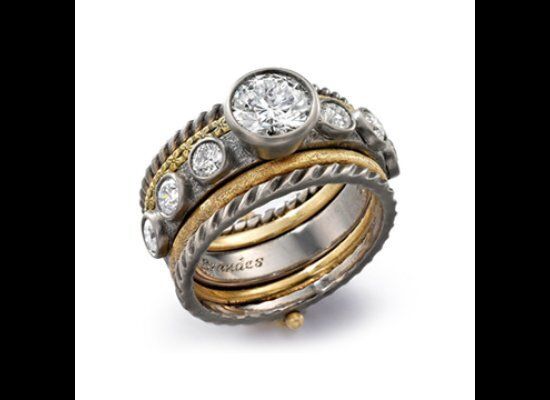I have a small fine-jewelry business. I've also had a root canal. I think they're very similar: Forewarned might be forearmed, but it doesn't eliminate the need for painkillers. I knew -- both from talking to people with experience and plain old common sense -- that the business would be the most challenging thing I'd ever done, job-wise. I was also told that the root canal would hurt. I still needed Percocet for the tooth ... and sometimes I wish I could have it for the business too.
Of course, there are joys to having a jewelry business. I love it when customers tell me that the earrings they bought from me online are even better than they expected; that their new necklace is their favorite jewelry ever; or that they can't take their eyes off their custom-made engagement ring. Redesigning old jewelry is especially rewarding. It's fun to convert an unworn cocktail ring into three streamlined stacking rings or give a lone stud earring new life as a pendant. My job even helped me make the most of my root canal: I engraved my gold crown with my initials.
The ache the business gives me -- in a place where molars don't grow -- comes from a classic small-business conundrum: the high cost of producing low quantity. You might think that problem is unique to my luxury jewelry line, where a one-of-a-kind 18K gold and diamond design can go for upwards of $20,000 and raw-material prices of metals have tripled since I launched in 2005. But every small, self-financed businessperson I speak to -- whether butcher, baker, candlestick maker, computer programmer, hair stylist, photographer or fashion designer -- tells me the same story. The problem is the cost of labor. Even when you're making goods out of inexpensive materials, you need to pay for labor. U.S. labor is expensive because, despite the ongoing recession, the U.S. has a high standard of living and a minimum hourly wage of $7.25. In countries without such a high standard of living, people will work for a dollar a day or less. That's why manufacturing and other jobs -- including customer-service phone lines, as many of us know -- have moved overseas. Using inexpensive labor enables companies to sell goods or provide services at prices U.S. consumers are willing to pay.
So why don't I move my production overseas, especially when a ring that cost $40 to produce in New York City cost $4 in Asia (before last year's surge in the price of silver)? Forget for the moment about quality issues and the idealistic wish to keep jobs in the U.S. I simply can't afford to produce cheaply. Factories require bulk orders because they would go out of business selling one $4 ring at a time. A minimum requirement for me is 100 units of each ring style. If I start ordering 100 rings at a time, I need to find a way to sell them or I'm going to drown in inexpensive rings. Quantity orders from retailers aren't easy to come by when you're a start-up. As Annie Lin, who, with her sister Karen, had a U.S.-made contemporary women's clothing line called AIRA from 2008 to 2011, tells me, getting the brand in front of customers was "the hardest part" because both boutiques and department stores "heavily relied on the 'usual' brands they often order from and leave a small budget for new designers." Limited distribution means limited profit, which scares off the kind of deep-pocketed investors who would be able to finance mass production. Another Catch-22.
Because I'll try anything once, I did the 100-unit order with a few styles, just to see if an inexpensive piece would fly off the proverbial shelf. I sold 30 of one style -- a large quantity for me -- all to individual customers. I made $20 on each sale and 30 trips to the post office. I'd rather hold out for one big engagement ring that nets $5,000 than do that again. At least I developed a better understanding of factories' requirements for large orders. My factory was giving me a break, really. A hundred units barely qualifies as mass production. Walmart is the gold standard of huge orders: A 2005 Wall Street Journal series identified a small order of pens for Walmart as 48,000 units.
Designers like me and the Lin sisters persist as long as we can, praying we'll have that "lightning in a bottle" moment: the right celebrity, the right store, the right press. Sometimes the money runs out before the moment comes. The AIRA line, which retailed from $180 to $550, was in seven boutiques but just breaking even when the Lins pulled the plug. Annie says, "In retrospect, if we did not find a celebrity to wear our clothing or somehow lower our price point ... we were looking at six or more years before seeing profit."
Maybe a design award will give me the push I need: I'm a finalist for Fashion Group International's Rising Star Award for jewelry (the awards will be announced on Thursday, January 26). My friend, designer Stacy Lomman, is also in an optimistic state of mind because she is a finalist for the Rising Star Award in women's wear after just 18 months in business. Financially, however, not much has changed for Stacy since 2010, when she was interviewed by the Huffington Post about her use of social media to finance her first runway show. Now preparing for her fourth show, she is conducting yet another campaign on the Kickstarter "crowdfunding" site to raise money to buy fabric for the 10 to 12 looks she'll sew singlehandedly. Being a Rising Star finalist means "I've proven that I am someone to watch," she says. A win could help her "secure some type of corporate sponsorship in order to take my business to the next level." Here's hoping that finding that financial backing isn't like pulling teeth.
